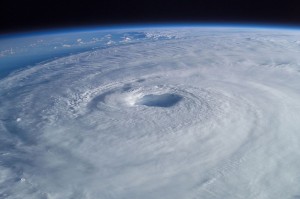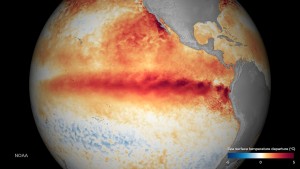Science Seen Physicist and Time One author Colin Gillespie helps you understand your world.
Taming the Destruction We can curb the Blob and show a profit
The number of climate-driven natural disasters per year has more than doubled since the 1980s. Meanwhile average global temperature increased less than one degree. We know how to slow the increase. It’s a win-win. Slowing it will keep us safer and will save all of us lots of money. Step one is to understand the enemy. How can such a small increase in temperature cause so much destruction?
Let’s follow it from the beginning. We burn millions-of-years-old hydrocarbons (oil and gas and coal) in vehicles and power stations, combining them with oxygen from the air. The total heat released since 1980 by all such sources would have increased global air temperature by a fraction of a degree; but most of it soon went into the oceans so the actual increase is even less. In fact it is negligible. Unlike engines in most cars and power stations, Earth’s engine of destruction doesn’t run on the heat of combustion; it runs on solar energy. Burning those hydrocarbons creates carbon dioxide. Increased CO2 causes our atmosphere to trap extra solar heat like a greenhouse, far more than the heat of combustion. This is how we warmed the world by nearly one degree. So the engine of destruction runs on slightly warmed sea water? In a word: Exactly.
The world’s weather is a flaky heat machine. It can turn that warm water into a heat wave or a blizzard, a  drought or a flood. For example, here’s how it makes one kind of destructive engine: a hurricane. The Sun warms the surface of the ocean a few degrees; one extra degree can make a huge difference. This heat evaporates some extra water. Water vapor makes the air next to the surface lighter than the air above it so the moist air rises. As it leaves the surface it sucks in air from far away that’s picking up more water vapor, etcetera. This updraft soon creates stupendous forces. Earth’s rotation makes it spin. Using only low-grade heat a hurricane has organized itself into a monster—maybe a trillion tons of air and water vapor moving faster than an express train. It vacuums up more moisture from the warm sea as it goes. When it makes landfall it may dump ten billion tons of rain onto a state-sized area. As all that water makes its way back down to the sea, it turns slopes and creeks into never-before-seen raging rivers.
drought or a flood. For example, here’s how it makes one kind of destructive engine: a hurricane. The Sun warms the surface of the ocean a few degrees; one extra degree can make a huge difference. This heat evaporates some extra water. Water vapor makes the air next to the surface lighter than the air above it so the moist air rises. As it leaves the surface it sucks in air from far away that’s picking up more water vapor, etcetera. This updraft soon creates stupendous forces. Earth’s rotation makes it spin. Using only low-grade heat a hurricane has organized itself into a monster—maybe a trillion tons of air and water vapor moving faster than an express train. It vacuums up more moisture from the warm sea as it goes. When it makes landfall it may dump ten billion tons of rain onto a state-sized area. As all that water makes its way back down to the sea, it turns slopes and creeks into never-before-seen raging rivers.
El Nino is a much bigger engine of destruction. Here’s how it works. Prevailing winds are driving a great blob of warm water across the Pacific Ocean to the west coast of the Americas. An area of several million square miles is about two degrees warmer than normal to a depth of a few hundred feet. This heat organizes extreme weather events world-wide. How much energy? The extra heat in this single El Nino blob is more than all the heat humankind has generated in the million years or so since we tamed fire. It’s like the energy of ten million one-megaton nuclear warheads!
 The Blob holds only some of the extra solar warming. Self-organizing weather patterns draw upon this kind of energy world-wide. They deliver what weather always delivers: blizzards, heat waves, hurricanes, tornados, floods and droughts, but now they deliver more of them and they are more extreme. Climate calculations told us to expect them. So far, China, the United States and India have had the worst damage. In the last decade it cost about a trillion dollars. We can already see that climate-driven damage in the next decade will cost much more.
The Blob holds only some of the extra solar warming. Self-organizing weather patterns draw upon this kind of energy world-wide. They deliver what weather always delivers: blizzards, heat waves, hurricanes, tornados, floods and droughts, but now they deliver more of them and they are more extreme. Climate calculations told us to expect them. So far, China, the United States and India have had the worst damage. In the last decade it cost about a trillion dollars. We can already see that climate-driven damage in the next decade will cost much more.
We all pay these bills one way or another. Slowing down the growth of the destruction engine will reduce our risks and it will cost us all a lot less money.
Other reading:
Colin Gillespie (2013), Time One: Discover How the Universe Began, New York: RosettaBooks, p. 136, http://www.rosettabooks.com/book/time-one/; “Getting Organized”, http://www.timeone.ca/chapters/getting-organized.pdf
Image credit: Mike Trenchard, Earth Sciences & Image Analysis Laboratory, Johnson Space Center

I have waited a long time to find a reasonable voice regarding climate change. I have lost trust in researchers doing ‘ Jeopardy Science’;by which I mean those ‘scientists’ who only receive grants or are published if the result will be ‘the problem is atmospheric carbon’. It’s ridiculous to believe that anyone could model climate with enough accuracy to make any kind of prediction(I’ve been hearing for the last quarter century, every five years, that while that last climate modeling program turned out to be totally inaccurate, this program totally nails it!) when we only know about 25% (I pulled that % out of my butt;everyone else seems to do it) of what we need to know about the Sun to make any guesses at all about its overall effect on climate. Unless I am way behind on my layman’s science , we also can only guess at the affect of solar and planetary pole shifts, the pole shift and gravity’s overall effect on the magnetosphere and Earth’s tectonic plates, which are likely the largest influence on ocean currents, which have massive effects on the jet stream,etc,etc.
I do actually believe that Man is affecting climate. However, I am convinced that carbon is a distraction that,while its not beneficial to the planet as a whole, is not the driver of climate change. My main concern is that we will be spending trillions to fix a symptom,and we completely miss the real cause that eventually kills us, much like building more tissue paper factories because everyone is developing a headcold.
Here is another theory that I am sure someone has probably raised; the drawdown of the world’s aquifers and the draining of all the surface water to the ocean. Over the last 50 to 60 years, we have pumped out between half to three quarters of our underground water supply. At the same time, we have increased the speed of surface land drainage so that rainstorms are drained more like a flushing toilet than adding to or draining a swimming pool. All this water used to have a moderating affect on the ground temperature; the aquifer acting as a massive expansion tank holding system, and the swamps, ponds, sloughs, and pothole lakes efficiently transferring heat and moisture from the ground to the atmosphere as nature intended. Once the heat and water are airbourn, the jet stream and local air currents can move them naturally. Alternatively, the dry, heated ground that we are creating now acts like a brand new mountain range to the jet stream, changing air currents and weather patterns across the planet. We are also contributing to rising ocean levels by pumping our subterranean water into the ocean(albeit in a small way). Happily, this is something we can fix easily.If the will existed, we could create enormous holding ponds next to waterways with sand-filled pipes drilled right down to the aquifers. The ponds would only need to be a fraction of a % of land currently in use(land that may become worthless if stuff don’t get fixed) and less than ten feet deep. We just need to slow the water down so it can be used to refill our aquifers.Then we can start working on stopping the dumping of sewage and plastics into the ocean,which I believe is one of the ways we are transferring heat deep into the ocean, more efficiently than the Sun and atmospheric carbon ever could; each little plastic particle carrying a calorie of heat from the surface as it sinks in the ocean x billions. Thank you for reading my rant.